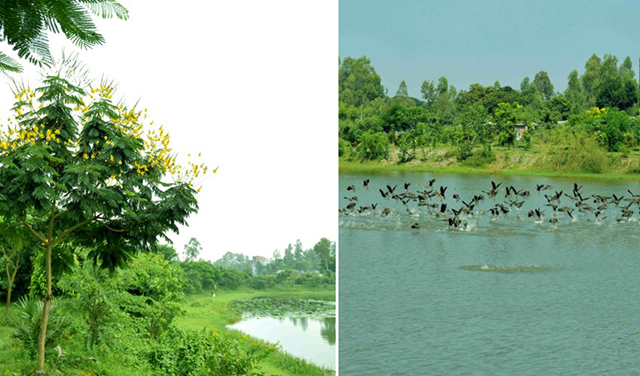
RANGPUR, Nov 25, 2023 (BSS) - Dazzling greenery all-around and chirping of migratory bird flocks, their free roaming on water and in the air and orderly flying scenes have given the re-excavated Bharardaho Beel a heavenly look.
Barind Multipurpose Development Authority (BMDA) has re-excavated the Beel under the five-year (2019-2025) term 'Expansion of irrigation in greater Rangpur district through best uses of surface water and conservation of rainwater (EIR) project'.
Local people said re-excavation of the extinct water body on the outskirts of Badarganj municipality in Rangpur has revived the lost ecosystems, improved the environment and created a matchless natural beauty attracting many visitors.
Hafizur Rahman of nearby village Dangapara said an incredible landscape has been created following re-excavation of the Bharardaho Beel and plantation of over 6,000 saplings of 213 rare and extinct species of wood, fruit, medicinal and flower plants on its bank.
"The Beel with profusely growing flora and fauna has become a sanctuary for birds and people are rushing there to enjoy the beauty of chirping guest birds, a botanical garden-like green nature and sprouting flowers," Rahman added.
Visiting couple Parveen Akhter and Shahidul Islam of Dinajpur said the flying guest birds, free movement of their wings and their landings on the water body have added a unique beauty there with greenery on all sides.
"We can not take away eyes from the re-excavated Bharardaho Beel that is now full of chirping of guest birds and varieties of rare species of plants on the surrounding banks with sight beholding scenes," Parveen said.
Visiting school student Susama Barman and college student Aklima Khatun said the re-excavated Beel has revived the lost ecosystems bringing back balance in nature to become a dazzling symbol of natural beauty with a divine look.
They suggested replicating the success achieved in reviving the ecosystems through re-excavation of the Bharardaho Beel in other extinct water bodies to adapt to adverse impacts of climate change.
Assistant Professor of Badarganj Women's Degree College Mahfuzul Haque Chowdhury Litan said re-excavation of the Bharardaho Beel has turned it into a sanctuary for local species of extinct fishes, birds and migratory birds after four decades.
"The BMDA should ensure better management of the re-excavated water body and turn it into an Eco-Park and sanctuary for birds and extinct species of indigenous fishes, watery plants, flora and fauna to further improve ecosystems," he said.
He feared the growing attractiveness of the re-excavated Bharardaho Beel might be disturbed if the water body is leased to local greedy people in the name of pisciculture or establishing a tourist spot there.
Environmentalist, Director of the Riverine People and Professor of Begum Rokeya University Dr. Tuhin Wadud said it is very good news that guest birds are seen in uncountable numbers in the re-excavated Bharardaho Beel after many decades.
"The re-excavated Beel continues reviving ecosystems at a time when drying-up of water bodies due to climate change threatens the environment forcing extinction of indigenous species of fishes, insects, birds and some animals," he said.
The Bharardaho Beel has factually become a sanctuary for migratory and local birds, indigenous small fishes, insects, small snails, algae, moss, aquatic plants and other stem-less watery plants.
He suggested the authorities concerned not lease the Beel to any private body, declare it as a sanctuary and ensure complete safety for birds, fishes and all living beings there.
Project Director of the EIR project and Superintending Engineer of BMDA for Rangpur Circle Md. Habibur Rahman Khan said people are enjoying stunning beauty of the re-excavated Bharardaho Beel with greenery all-around, chirping guest birds and their mannerly flying.
"The project is being implemented to promote agriculture and livelihoods making best use of conserved surface water, forestation and improve ecosystems and revive sanctuaries for indigenous species of extinct fishes, birds and migratory birds," he said.